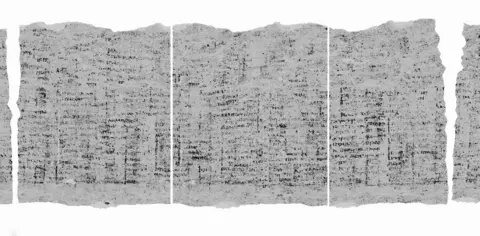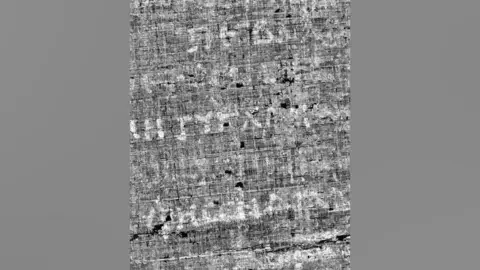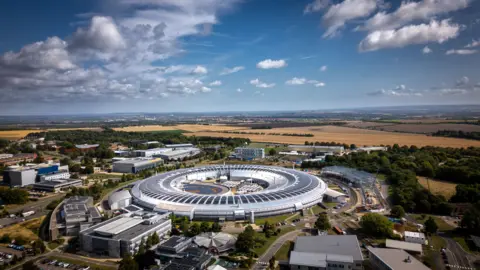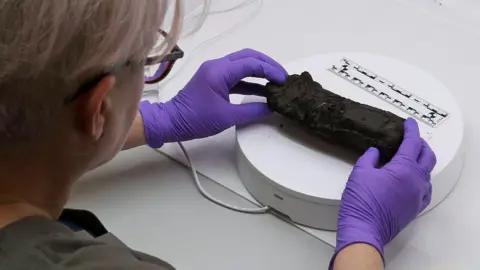Senior Science Journalist
 Vesuvius Problem
Vesuvius ProblemA badly burnt scroll from the Roman city of Herculaneum has been digitally “unwrapped”, offering the primary look inside for two,000 years.
The doc, which seems to be like a lump of charcoal, was charred by the volcanic eruption of Mount Vesuvius in 79AD and is just too fragile to ever be bodily opened.
However now scientists have used a mix of X-ray imaging and synthetic intelligence to nearly unfurl it, revealing rows and columns of textual content.
Extra work is required to make the scroll absolutely legible to decipher its contents, however the workforce behind the challenge say the outcomes are very promising.
 Bodleian Library
Bodleian Library“We’re assured we will learn just about the entire scroll in its entirety, and it is the primary time we have actually been in a position to say that with excessive confidence,” mentioned Stephen Parsons, challenge lead for the Vesuvius Problem, a world competitors making an attempt to unlock the Herculaneum scrolls.
Some letters are already clearly seen within the historic textual content and the workforce believes it is a work of philosophy.
 Vesuvius Problem
Vesuvius ProblemTons of of carbonised scrolls have been found in Herculaneum, which like its neighbour Pompeii was buried beneath metres of volcanic ash.
Previously, a few of the paperwork, that are produced from a thick paper-like materials referred to as papyrus, have been prised open however they crumbled into items.
The College of Oxford’s Bodleian Library holds a number of of the scrolls. Regarded as unreadable, they’d been left untouched for many years.
“We have by no means been satisfied earlier than that any of the strategies could be secure sufficient or efficient sufficient to get any data from the scrolls,” defined Nicole Gilroy, head of e-book conservation.
However the promise of a hi-tech answer prompted the workforce to get one of many treasured scrolls out of storage.
 Tony Jolliffe/PJDM
Tony Jolliffe/PJDMIt was positioned in a specifically made case and brought to Diamond Gentle Supply in Oxfordshire.
Inside this big machine, which is known as a synchrotron, electrons are accelerated to virtually the pace of sunshine to supply a robust X-ray beam that may probe the scroll with out damaging it.
“It could possibly see issues on the dimensions of some thousandths of a millimetre,” defined Adrian Mancuso, director of bodily sciences at Diamond.
The scan is used to create a 3D reconstruction, then the layers contained in the scroll – it accommodates about 10m of papyrus – must be recognized.
“We now have to work out which layer is totally different from the following layer so we are able to unroll that digitally,” mentioned Dr Mancuso.
After that synthetic intelligence is used to detect the ink. It is simpler mentioned than carried out – each the papyrus and ink are produced from carbon they usually’re virtually indistinguishable from one another.
So the AI hunts for the tiniest alerts that ink is likely to be there, then this ink is painted on digitally, bringing the letters to mild.
 Bodleian library
Bodleian library“We will inform your entire scroll is filled with textual content,” mentioned Stephen Parsons.
“Now we are able to work on making it present up extra clearly. We’ll go from a handful of phrases to essentially substantial passages.”
Final yr, a Vesuvius Problem workforce managed to examine 5% of one other Herculaneum scroll.
Its topic was Greek Epicurean philosophy, which teaches that fulfilment will be discovered by means of the pleasure of on a regular basis issues.
The Bodleian’s scroll is more likely to be on the identical topic – however the Vesuvius workforce is asking for extra human and computing ingenuity to see if that is so.
For Nicole Gilroy, the work is offering a hyperlink to the previous.
“I simply love that reference to whoever collected them, whoever wrote them, whoever rolled these scrolls up and put them on the cabinets. There’s an actual human facet to it that I simply suppose is basically treasured,” she mentioned.
#glimpse #burnt #scroll #years
, 2025-02-05 05:41:00


